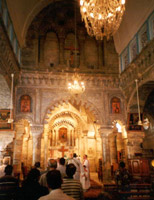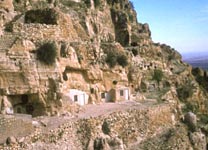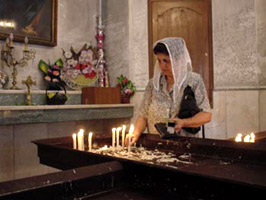Christianity
The Beginning of the Christianity.
 St. Thomas the doubting apostle brought the Christianity to the ancient
Mesopotamia in 33 A.D. History clearly indicated that St. Thomas came
from the Syrian city of Edessa (present day Urfa in southern Turkey).
Two more strong Christians came with him, Mar Addai and Mar Mari. (Mar
in Aramaic means Lord), to establish the Assyrian Church of the East.
St. Thomas the doubting apostle brought the Christianity to the ancient
Mesopotamia in 33 A.D. History clearly indicated that St. Thomas came
from the Syrian city of Edessa (present day Urfa in southern Turkey).
Two more strong Christians came with him, Mar Addai and Mar Mari. (Mar
in Aramaic means Lord), to establish the Assyrian Church of the East.
The church centered and spread from the Assyrian city of Arbil (in the
north of Iraq)
Early Mesopotamian Christianity was Semitic Linguistically. They spoke
Aramaic in Syria, Palestine, Assyrian and Chaldeans, (Babylonians)
empires.
As Christianity spread in both the Assyrian and the Chaldeans people
more and more accepted Christ. On the north the Assyrian king
Sennacherib (he is not the same king in the years B.C) was upset to know
that Sheik Matti baptized his son Behnam and his daughter Sarah. They
were both beheaded. Sheik Matti or Mar Matti joined with many monks
lived in the mountains out side Mosul. They lived in caves, carved small
rooms to live in all over the mountain. Since the King was very upset
with them, they carved a tunnel in the mountain and as soon as they see
the army is coming to kill them, the monks rush to the tunnel, close the
out side door by rocks and stay on the other side of the mountain until
the army retreat.
King Sennacherib he asked Mar Matti to baptize him. Christianity became
the official religion of the country.
Many churches still exist from the early days, like the old church of
Saint Simon Al- Safa in Mosul. Under the vault a beautiful inscription
in Syriac language, was made by brick and marble. It is still standing
in spite of so many wars and destructions.
On the fourth century several schools of thoughts evolved.
-
The school of Alexandria led by
St. Cyril, which pressed Jesus divine nature.
-
The school of Antioch led by Nestorios the patriarch of Constantinople, which advocated Jesus
humanity.
Also they did not agree how to deal with our Lady. St Cyril called
her the God- Bearer, while the second school said she is Christ
bearer. In the year 431 A.D. the Ecumenical council of Ephesus
rejected the second school and adopted St. Cyril school. The
Mesopotamian church rejected the council. Since the Byzantine
emperor in the west wanted to follow St. Cyril School to bring all
Christians together. The Church of Mesopotamia accepted the
Nestorian church for a political reason and not to be under the
control of the Byzantines.
Now the three major sections of Christianity in Iraq are:
-
The Apostolic Catholic Assyrian church of the east, estimate
800,000 members.
-
The Assyrian Orthodox Church, about 700,000 members.
-
The Chaldeans church of Babylon were 1,000,000 members, down to
800,000 (since many have left Iraq).
In the Seventh century, Islam reached Mesopotamia, Palestine and North
Africa. Islam became the dominant religion in Mesopotamia, Persia,
Turkey, Syria and Palestine.
 The dominant church of the region, the Assyrian Church of the East
(Nestorian) developed as a great missionary body. From Mesopotamia they
spread the Christianity to India, China and other countries. They
established monasteries and schools and even converted a ninth century
Chinese emperor and his court. The Indian Christianity traces its
foundation to the Nestorian church of Mesopotamia.
The dominant church of the region, the Assyrian Church of the East
(Nestorian) developed as a great missionary body. From Mesopotamia they
spread the Christianity to India, China and other countries. They
established monasteries and schools and even converted a ninth century
Chinese emperor and his court. The Indian Christianity traces its
foundation to the Nestorian church of Mesopotamia.
In 634 Arabs spreading the religion of Islam appeared in Mesopotamia and
brought the entire region under the faith of Islam where it remains
today. The Islam accepted the Christianity and Judaism as a religion of
God. It is written in the Koran that both Jesus and Moses are Prophets.
In the 16th century portions of the Church of the East sought relief by
establishing relations with the Church of Rome. Thereafter, those
Christians in union with Rome were known as Chaldeans whereas the
remaining Christians were called Assyrians.
The Chaldean Church, like some other autonomous Eastern Catholic
Churches, is under the jurisdiction of its own patriarch and hierarchs
in peace and communion with Rome and retains its own distinctive
theological, liturgical and canonical traditions. Unlike the Byzantine,
Roman and Coptic Churches, the Chaldean Church has no distinctive
liturgical arts traditions in decorating its churches, but borrows
heavily from the Byzantine and Roman traditions.
The Christian minorities in Iraq are among the oldest in Christendom.
They make up today about 4% of the population numbering fewer than one
million out of a population of 24 million, although the number has
dwindled to below 800,000 in recent years as many left for Europe and
the United States. They consist of two main groups:
-
The Catholics (650,000)
A. Chaldean Rite: more than 600,000 with one patriarch (Babylon in
Baghdad); four archdioceses (Kirkuk, Mosul, Basra & Arbil; and five
dioceses (Alqosh, Amadijah, Aqra, Sulaimaniya & Zakhu)
B. Syrian Rite: more than 47,000 with two archdioceses (Baghdad and
Mosul)
C. Latin (Roman) Rite: more than 4000 with one archdiocese
(Baghdad).
D. Armenian Rite: more than 3000 with one archdiocese (Baghdad).
-
The Other Christians (200,000)
A. The Church of the East, formerly Nestorian. More than 150,000.
B. Syrian Orthodox: More than 40,000.
C. Armenians. More than 5000.
The Ancient Church of the East -- the Assyrian Church -- is the
oldest church in Iraq. It became regarded as Nestorian in tradition
because its theology was similar to that of the Orthodox patriarch
of Constantinople, Nestorians. The Nestorian center,
Seleucia-Ctesiphon near Baghdad, was at one time the most important
patriarchate beyond the borders of the Roman empire and was largely
responsible for the early extension of the Christian faith to other
parts of the Middle East and Asia.
Syrian Orthodox (also called Jacobites) entered Iraq in the 6th
century and consider themselves the true Iraqis among the various
Orthodox groups in the country.
Most Catholics belong to the Chaldean Church, which was organized
with Rome under its patriarchate in 1553. The patriarch of Babylon
lives in Baghdad. There is a seminary in Mosul, jointly sponsored by
Chaldean and Syrian Catholics.
Other ancient churches include Armenian Orthodox and Armenian
Catholics, who fled from Turkish massacres in the early 20th century
and established themselves in Iraq. Greek Orthodox and Greek
Catholics are small communities composed largely of immigrants from
Syria, Lebanon and Palestine.
State schools having a Christian majority provide Christian
religious instruction. Christian students in state schools with a
Christian minority receive no religious instruction, except that
provided by churches. The Armenian Orthodox church operates primary
schools and a high school.
List of Christian Churches in Baghdad - Iraq
The following listing of Christian churches in Baghdad - Iraq:
Chaldean Church (Catholic denomination):
1. "Pregnant without Sin" (in reference to Virgin Mary), built in 1921 -
Camp Gelani.
2. Mar Aphram, built in 1940s - Shalcheya.
3. Mar Yousif, built in 1956 - Eastern Karada.
4. Mar Youhanan the Baptist, built in 1960 - alDura.
5. Holy Family, built in 1960 - Aurfaleya (Betaween)
6. The Virgin- Prayer's Lord (Sultana alWardeya), built in 1960 - Karada
Khareg.
7. Holy Heart of Jesus, built in 1964 - Hay alWehda.
8. Mar Eliya of Heyra, built in 1964 - Hay alAmeen.
9. Mar Yousif- Protector of the Workers, built in 1965 - Hay alYarmook
10. Mar Yaqoub- Bishop of Nisibin, built in 1965 - alDura
11. The passing of the Virgin, built in 1966 - alMansour
12. Mar Toma the Disciple, built in 1966 - Nereya and Gayara
13. Mother of Continuous Help, built in 1966 - Hay anNedhal and alSadoon
14. The Virgin- Protector of Crops, built in 1968 - alBayya'
15. Mar Gewergis, built in 1969 - Hay Sumer/New Baghdad
16. Virgin Mary, built in 1971 - Palestine Street
17. Martyr Mar Baythoon, built in 1978 - Baladeyat/7-April
18. Holy Trinity, built in 1978 - Habebeya/7-April
19. Mar Marey, built in 1980 - Hay Beydha/alBanook
20. The Disciples Mar Putros and Mar Polos, built in 1986 - alDura
21. Congratulating the Virgin, built in 1989 - Hay alMuthana/Suq
alThelatha
22. The Rising, built in 1994 - Hay alMualemeen/alMashtal
23. Mar Polos- The Disciple, built ??, al-Zafaraneya
Assyrian (include Assyrian, Assyrian Evangelical, and Old Assyrian):
1. Virgin Mary (Mar Kura), built in 1928 -Karada Maryem
2. Mar Qaradagh, built in 1946 - Camp Gelani
3. Evangelical Assyrian, built ??, Sahat alTayaran
4. Mar Gewergis, built in 1961 - alDura
5. Mar Odishu Nokhreta, built in 1972 - Elwiya
6. Virgin Mary, built in 1970 - Neyreya and alGayara
7. Mar Marey, built in 1985 - alAmeen
8. Mar Zaya, built in ?? - alDura
9. Virgin Mary (Old Assyrian Church), built in 1988 - Hay alReyadh
Syriac (include Orthodox and Catholic):
1. The Disciples Mar Putros and Mar Polos (Orthodox), built in 1964 -
Industerial Street
2. Mar Yousif (Catholic), built in 1965 - alMansour
3. Lady of Salvation (Catholic), built in 1968 - Eastern Karada
4. Mar Maty (Orthodox), built in 1981 - Hay Sumer/Ghadeer
5. Mar Toma (Orthodox), built in 1978 - alMansour/Hay alMuhandeseen
6. Mar Behnam (Catholic), built in 1982 - Hay Sumer/alQanat
7. Mar Behnam (Orthodox), built in ?? - Hay alMechanic/alDura
Armenian (include Catholic and Orthodox) :
1. Holy Heart of Jesus (Catholic), built in 1938 - Eastern Karada
2. St. Gregor the Illuminant (Orthodox), built in 1956 - Sahat alTayran
3. St. Garabeet (Orthodox), built in 1973 - Hay alReyadh
Melkite, known commonly as "Room" (include Orthodox, Catholic and Latin:
1. Mar Anderaous (Orthodox), built in 1940's - Camp Gelani
2. Room Catholic, built in 1962 - Karada Dakhel
3. St. Jerjis (Orthodox), built in 1976 - Hay alReyadh
4. Cathedral of St. Joseph (Latin), built in 1965 - Hay alWehda/Elwiya
Protestant:
1. Adventest Church, built in 1958 – al Nedhal Street
Evangelical:
1. National Evangelical, built in 1954 - Hay al Nedhal


